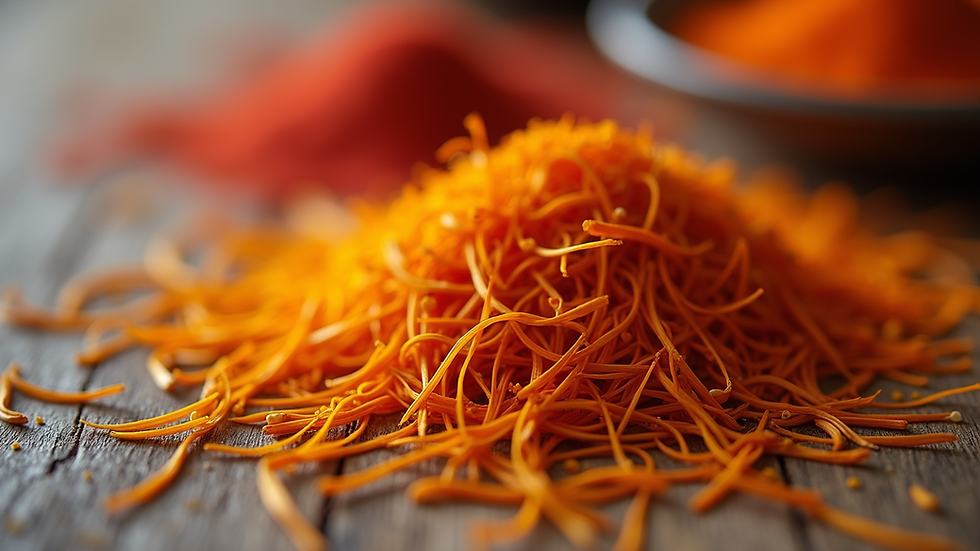Saffron and Pistachio The Heart of Persian Culinary Tradition
- Tivaasi
- 2 days ago
- 3 min read
Saffron and pistachio are not just ingredients in Persian cuisine; they are the soul of the culinary tradition, rich in flavor, history, and cultural significance. These two elements are often featured in an array of Persian dishes, from savory meals to sweet delights, highlighting the depth of Iran's gastronomic heritage. Let’s explore why saffron and pistachio are so important, their cultural meanings, and their roles in traditional recipes.
The Significance of Saffron in Persian Culture
Saffron, known as "zaferan" in Persian, is frequently called the "golden spice." This precious ingredient comes from the flower of Crocus sativus and is renowned for its vibrant hue and distinct taste. Historically, its use in Persian culture extends beyond food to encompass medicinal and ceremonial roles.
In Persian society, saffron symbolizes prosperity and luxury. The high price of saffron, often exceeding $1,000 per pound, reflects the labor-intensive harvesting process, where over 150,000 flowers yield just one kilogram of saffron threads. As a result, it is reserved for special occasions and major celebrations like weddings and religious festivals.
Commonly, saffron is incorporated into various rice dishes. One classic example is Tahchin, a rice cake layered with chicken or lamb, where saffron creates an inviting aroma and a stunning golden appeal. Another dish, Shirin Polow, combines saffron with nuts and dried fruits, showcasing a beautiful blend of colors and flavors.

The Role of Pistachio in Persian Cuisine
Pistachios, referred to as "pesteh" in Persian, play a significant role in the culinary tapestry of Iran. These nuts are not only tasty but also nutrient-dense, making them a versatile ingredient for sweet and savory dishes. The cultivation of pistachios in Iran dates back over 3,000 years, and they are often given as a token of hospitality.
In Iranian culture, pistachios are frequently served as snacks at social gatherings. Roasted and salted, these nuts provide a satisfying crunch that complements a variety of dishes. They are also key ingredients in traditional sweets like Baklava, where the nutty richness pairs perfectly with layers of pastry and syrup, and Saffron Ice Cream, which combines vanilla with hints of saffron and garnished with crushed pistachios.
Culturally, pistachios symbolize generosity and good luck. Their bright green hue embodies freshness and vitality, making them popular in festive meals and gifts during celebrations such as Nowruz, the Persian New Year.

The Fusion of Saffron and Pistachio in Persian Desserts
The delicious pairing of saffron and pistachio is a signature of many Persian desserts, offering a beautiful combination of flavors and colors. Take, for instance, Saffron and Pistachio Rice Pudding. This creamy dish is made by simmering rice with milk and sugar. The generous addition of saffron lends a luxurious golden tone, while chopped pistachios sprinkled on top provide a delightful crunch. This dessert is not only tasty but also visually captivating, often served at family gatherings and celebrations.
Another beloved treat is Zoolbia and Bamieh, traditional Persian sweets made from deep-fried dough drenched in syrup. Saffron is infused in the syrup, adding depth, while crushed pistachios are used as a garnish. This dish exemplifies how simple ingredients can transform into something extraordinary, perfect for sharing with family and friends.

Celebrating Persian Culinary Traditions
Saffron and pistachio represent more than just culinary components; they are emblems of culture, tradition, and hospitality. Their distinctive flavors and vibrant colors enhance an array of dishes, weaving them into the very fabric of Persian culinary art.
As you embark on your journey through Persian cuisine, consider trying your hand at dishes that feature saffron and pistachio. Whether preparing a festive spread or a simple dessert, these ingredients promise to elevate your culinary experience and connect you with Iran's rich cultural heritage. Embrace these gems of Persian cooking and enjoy the delicious flavors they bring to your table.




Comments